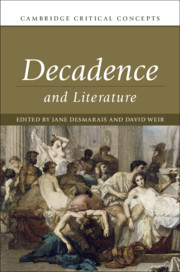Book contents
- Decadence and Literature
- Cambridge Critical Concepts
- Decadence and Literature
- Copyright page
- Dedication
- Contents
- Figures
- Contributors
- Acknowledgements
- Introduction
- Part I Origins
- Chapter 1 Decadence in Ancient Rome
- Chapter 2 Decadence and Roman Historiography
- Chapter 3 Nineteenth-Century Literary and Artistic Responses to Roman Decadence
- Chapter 4 Decadence and the Enlightenment
- Chapter 5 Decadence and the Urban Sensibility
- Chapter 6 Decadence and the Critique of Modernity
- Chapter 7 Decadence and Aesthetics
- Part II Developments
- Part III Applications
- Select Bibliography
- Index
- References
Chapter 3 - Nineteenth-Century Literary and Artistic Responses to Roman Decadence
from Part I - Origins
Published online by Cambridge University Press: 12 August 2019
- Decadence and Literature
- Cambridge Critical Concepts
- Decadence and Literature
- Copyright page
- Dedication
- Contents
- Figures
- Contributors
- Acknowledgements
- Introduction
- Part I Origins
- Chapter 1 Decadence in Ancient Rome
- Chapter 2 Decadence and Roman Historiography
- Chapter 3 Nineteenth-Century Literary and Artistic Responses to Roman Decadence
- Chapter 4 Decadence and the Enlightenment
- Chapter 5 Decadence and the Urban Sensibility
- Chapter 6 Decadence and the Critique of Modernity
- Chapter 7 Decadence and Aesthetics
- Part II Developments
- Part III Applications
- Select Bibliography
- Index
- References
Summary
This chapter examines the nineteenth-century cultural interest in Roman decadence, curious in view of the many historical figures who typified such Roman virtues as dutifulness to family and the gods, self-sacrificing patriotism, heroic manliness. To focus instead on the extravagance, weakness, and sexual deviance of the emperors was to exhibit the perversity for which decadent culture is renowned. A sense of belatedness, a feeling that the greatness of the past is gone forever, connects the Silver Age and the late-nineteenth century, inspiring a pessimistic world view but also a freedom from the artistic and linguistic restrictiveness of a self-consciously great era. Yet the transition from virtuous to dissolute impressions of Rome is not simply a phenomenon of the fin de siècle: the subversive insinuations of melancholy, self-indulgence, effeminacy, extravagance, embellishment, and foreign influences in the literature of the Golden Age resonate with romantic sensibilities and react against imperial ambitions to destabilize exemplary images of Rome throughout the nineteenth century.
- Type
- Chapter
- Information
- Decadence and Literature , pp. 47 - 65Publisher: Cambridge University PressPrint publication year: 2019
References
- 2
- Cited by



